|
GETAC S400
Semi-rugged notebook computer offers Intel Core i3/i5 power, excellent connectivity, optional resistive multi-touch, all at a very fair price
(by Conrad H. Blickenstorfer -- photography by Carol Cotton)
In October of 2010, Getac announced a new addition to its growing lineup of tablet, handheld and notebook computers built to last. The S400 is a "semi-rugged" full-featured notebook computer specifically designed for use in a variety of field applications that require more toughness and durability than consumer products can provide, but not the higher weight and cost of fully ruggedized construction. Target deployment for semi-rugged systems includes utilities, field service, public safety, as well as military applications and vehicle use. RuggedPCReview.com had a chance to spend a couple of months with the Getac S400, and this review describes the machine, its features, and where it fits in.
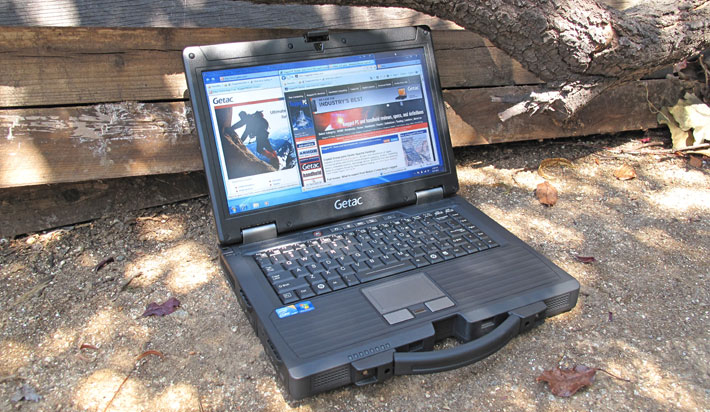
Getac S400 positioning
What is the Getac S400 and who needs it? In essence, it is designed to be a more durable and more mobile alternative to the common consumer and corporate notebook computer. It's made for those whose laptops spend more time on the road and outdoors than on desks, but within reason and not to the extreme. The S400 looks a lot like Getac's fully rugged notebooks, but it costs a lot less—about twice as much as a consumer notebook, but only half as much as a fully rugged machine.
The somewhat lighter build also means it won't weigh you down more than necessary: The S400 measures 13.7 x 10.15 inches, is just under two inches thick, and weighs just under seven pounds. To put it in perspective, that's about the footprint of a 15-inch MacBook Pro. The S400 has a 14-inch LCD display with the fashionably wide-format 16:9 aspect ratio and WXGA 1366 x 768 pixel resolution, which also so happens to be the same as the 720p high definition TV standard.
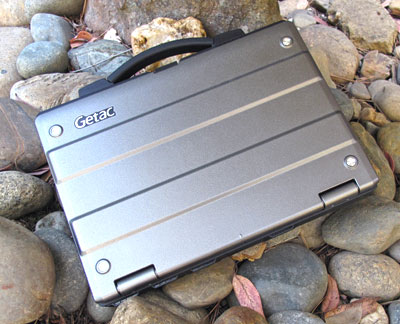 What sets the S400 apart from a standard notebook is that it's clearly built to be used outdoors and on the job. The display is semi-matte so as to avoid the reflections that plague the glossy screens of consumer notebooks. There's an integrated handle to carry the device without the need to carry an attache case as well. There's a touch screen because that often works well with field applications. Most of the ports have protective covers because it can get dusty and wet out there. And everything is sturdy enough to absorb the occasional bump or blow. If the S400 were a car it'd be an offroad-capable SUV, more able to take a beating out there, but not as extreme (or expensive) as a military Humvee. What sets the S400 apart from a standard notebook is that it's clearly built to be used outdoors and on the job. The display is semi-matte so as to avoid the reflections that plague the glossy screens of consumer notebooks. There's an integrated handle to carry the device without the need to carry an attache case as well. There's a touch screen because that often works well with field applications. Most of the ports have protective covers because it can get dusty and wet out there. And everything is sturdy enough to absorb the occasional bump or blow. If the S400 were a car it'd be an offroad-capable SUV, more able to take a beating out there, but not as extreme (or expensive) as a military Humvee.
A semi-rugged notebook in this class is also expected to have enough performance to run almost any application well, a display bright enough to be used out in the sun, cover all the bases in wireless communication, have enough onboard connectivity to hook up to almost anything, and there must also be a full-size keyboard to make typing bearable in the field. The Getac S400 delivers in all these areas.
In terms of competition, the Getac S400 seems squarely aimed at Panasonic's Toughbook 53, or perhaps the other way around as the S400 was there first. There are other contenders as well in the semi-rugged notebook market. Dell has toughened ATG and XFR versions of some of its consumer notebooks, and there are several Taiwan-based OEMs that sell durable and semi-ruggeds under various brand names and sometimes also their own. For customers seeking a semi-rugged from one of the traditional rugged computing vendors, the Getac S400 will definitely be on the short list.
Design and construction
The Getac S400 is a very attractive machine. Its matte black and gun-metal gray color scheme is elegant, timeless, and exudes just the right degree of toughness. It's a successful combination of industrial design with mechanical-looking details that give the computer a sharp, purposeful no-nonsense look. Note, however, that unlike Getac's fully rugged models, the S400's case is made of what Getac calls "KryptoShell" plastic material, and not magnesium-alloy. Regardless, the S400 looks and feels as tough and solid as the magnesium-clad models. Below you can see the unit from the top and all four sides:

Before I go much farther, I should also mention that while the Getac S400 is definitely a tough machine that can take a beating, it is not designed to be fully waterproof. Getac calls it "water resistant," but that really just means it can handle a spill onto its keyboard and perhaps a bit of rain. And the protective doors also keep water at bay. But the S400 is not a sealed machine. There are grills and other openings to the inside through which water can get in, and that's why the machine does not carry an IP rating for liquids.
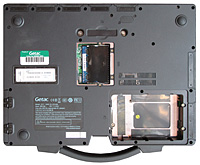 On the bottom of the S400 are two removable plastic covers. Beneath one of them, a vented one, are the unit's two memory module slots, populated in our eval unit with two 2GB Nanya 1,333MHz SODIMMS. Beneath the other sits the separate shock-mount hard drive caddy. To gain full access to the inside of the unit, you need to remove the entire plastic bottom cover. It is secured with about 20 Philips screws, then comes off easy. The picture below shows the Getac S400 with its bottom cover removed.
On the bottom of the S400 are two removable plastic covers. Beneath one of them, a vented one, are the unit's two memory module slots, populated in our eval unit with two 2GB Nanya 1,333MHz SODIMMS. Beneath the other sits the separate shock-mount hard drive caddy. To gain full access to the inside of the unit, you need to remove the entire plastic bottom cover. It is secured with about 20 Philips screws, then comes off easy. The picture below shows the Getac S400 with its bottom cover removed.
The motherboard measures about 13 x 5.7 inches and sits underneath the keyboard. There does not appear to be a metal frame or chassis; instead, everything is mounted onto the very sturdy "KryptoShell" plastic case. Almost all of the unit's external interface ports are edge-mounted onto the motherboard. There are also a number of subsidiary boards. The largest one had connectors for the hard disk, as well as two USB 2.0 and a IEE1394 FireWire port. Overall, the motherboard and interior circuitry is very clean, very solid, and very well laid out. There are no fixes, and everything is properly secured. Very impressive is also the amount of detail on the inside of the case: there are even guides for wires!
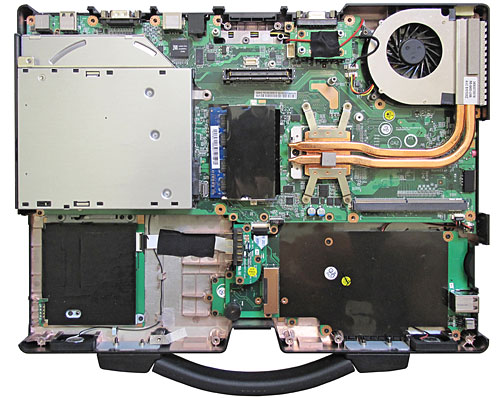
The most noticeable part of the motherboard is its copper thermal management system. A small copper heat spreader sits on top of the Core i5 processor. Two copper heat pipes then remove heat from the CPU to the fan assembly. Despite the relatively high 35-watt thermal design power of the Core i5-520M processor, the system apparently can make due without an additional heat sink in the form of a magnesium backplate (as the B300 has). There is also no additional heat piping to the chipset or other chips. The fan does it all.
 The hard disk caddy (see image to the right) is a remarkably intricate affair consisting of a metal outer housing with different types of padding inside, certainly more than enough to keep the 80GB Intel ssdsa2M080G2GC solid state disk in our eval unit safe and sound. The installed (and easily removable) optical drive was a Sony Optiarc AD-7585H SATA DVD+/-RW rewritable. The hard disk caddy (see image to the right) is a remarkably intricate affair consisting of a metal outer housing with different types of padding inside, certainly more than enough to keep the 80GB Intel ssdsa2M080G2GC solid state disk in our eval unit safe and sound. The installed (and easily removable) optical drive was a Sony Optiarc AD-7585H SATA DVD+/-RW rewritable.
The battery is a powerful 11.1 Volt/7,800mAH 87 watt-hour unit with a built-in battery gauge that shows charge status via four lights upon pressing the button next to it. You can't see the charge meter when the battery is installed in the unit, but it comes in handy when you carry spare batteries around. The battery can be removed if the unit is plugged in, but it is not hot-swappable.
As a full-size semi-rugged notebook, the S400 comes with a full complement of ports, all of which are protected either by rubber plugs or hinged doors. The pictures below show the left and the right side of the S400, both with the doors open.
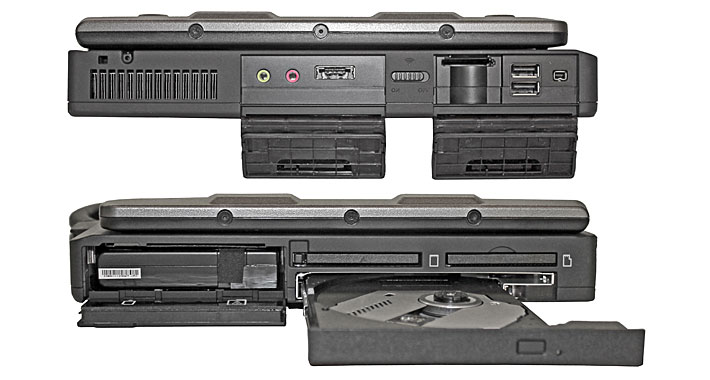 On the left side of the unit (top picture) starting on the left are the fan vent with a garage for the 3.5-inch telescopic stylus and its tether anchor point on top of it. To the right of the vent is an I/O block with audio-out and microphone connectors and an eSATA/USB combo port. Next to that is a master RF switch that turns all radios off. If it's in on position, individual radios can be software controlled. To the right of that is another I/O block, this one with a multi-card reader (SD Card, Memory Stick and Memory Stick PRO), two USB 2.0 ports, and a mini IEEE1394 "Firewire" port. Both I/O blocks have plastic protective covers that provide good sealing.
On the left side of the unit (top picture) starting on the left are the fan vent with a garage for the 3.5-inch telescopic stylus and its tether anchor point on top of it. To the right of the vent is an I/O block with audio-out and microphone connectors and an eSATA/USB combo port. Next to that is a master RF switch that turns all radios off. If it's in on position, individual radios can be software controlled. To the right of that is another I/O block, this one with a multi-card reader (SD Card, Memory Stick and Memory Stick PRO), two USB 2.0 ports, and a mini IEEE1394 "Firewire" port. Both I/O blocks have plastic protective covers that provide good sealing.
On the right side of the computer, again from left to right, is the battery compartment with recessed Smart Card and SIM card slots. The battery compartment has a hinged protective door with two springloaded locking levers. It won't open by accident. Next to that a PC Card slot and an ExpressCard slot that can handle either 34 or 54mm cards. Underneath the slots is the optical drive. The S400 comes with plastic inserts for when the two card slots are not in use. Neither the slots nor the optical drive have sealing, so this part is vulnerable to liquids.
Along the backside of the S400 (see picture below) are, from left to right, the power connector and another USB 2.0 port underneath a plastic protective door, a serial RS232 DB9 port under a separate protective door, an RJ45 LAN jack and an optional RJ11 modem port under a combined door, a VGA connector for external video, and a Kensington lock slot.

The hinged protective port covers are screwed onto the body of the S400 via two Philips screws each, making replacements very easy should they break.
The front of the unit does not have any connectors or ports other than the two speakers to the left and right of the unit. There wouldn't be room for anything else as most of the front is taken up the large, springloaded rubber handle that is screwed onto the system side of the computer. There are, however, no fewer than eight indicator lights built into the left side of the case. They show the status of power, battery, hard disk activity, Num Lock, Caps Lock, WiFi, Bluetooth and GPS, and remain visible even when the LCD lid is closed.
Keyboard and hardware controls
The S400's 88-key keyboard is full-scale. It has beveled black keys with white labels. Instead of using less legible blue for function key combos, Getac used white for those labels also, but placed them in little white square boxes. All those white labels make the keyboard look a little busy, but it works very well, with nice tactile feedback.
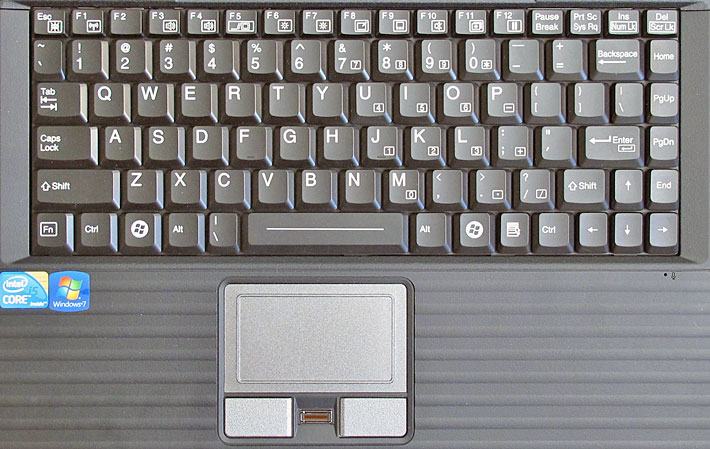
Below the keyboard is a flush-mounted area area that includes the touchpad, mouse buttons and fingerprint scanner. The touchpad is optimally sized and very responsive. Its work surface is marked by a slightly raised border so that you can always feel where it starts and ends. The two mouse buttons are also properly sized, and they have a slightly rough powdercoat finish that provides just the right amount of grip. The small fingerprint reader is placed between the two mouse buttons.
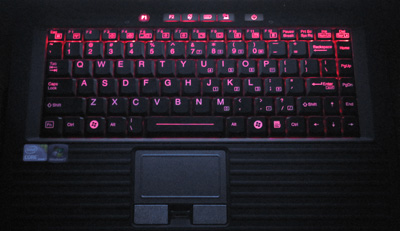 The S400's keyboard has a red LED-based backlight that can be activated and toggled through three brightness settings via a function key combination. It's pleasant and clearly illuminates the keys in semi and full darkness. The keyboard backlight is an option, and one that we recommend. The S400's keyboard has a red LED-based backlight that can be activated and toggled through three brightness settings via a function key combination. It's pleasant and clearly illuminates the keys in semi and full darkness. The keyboard backlight is an option, and one that we recommend.
One slightly annoying thing with this design is that when viewed from an angle, the red illumination peeking out between keys can overwhelm the actual illumination of the key.
Above the keyboard are five hardware pushbuttons (see image below) as is the custom with Getac's current lineup of rugged notebooks. From left to right, they are:
- P1 starts the G-Manager
- P2 starts Internet Explorer
- Blackout mode toggle that turns off backlight and all other lights and illuminations
- ECO button for engaging power conservation mode under battery power
- High-Bright button toggles full 700 nit power backlight on and off
- Power

Having hardware buttons to turn quickly off the display and make it super-bright comes in very handy. It's much quicker than fumbling with menus. On the other hand, it's not obvious why the G-Manager button is red and separate while the power button is on the side, and Getac should standardize the layout across all of its machines.
Performance
Selecting the right processor and level of performance for a notebook computer means having to make some hard decisions. Fast is always good, but in notebooks fast generally also means a bigger battery, more cooling, and that usually means higher weight and cost. This is where product placement comes in. A semi-rugged notebook probably won't spend as much time away from desks and power outlets as a tablet or fully rugged system, which means that most customers probably value good performance even if it means the machine weighs a bit more. So what did Getac decide for the S400?
They went for good performance with two dual processor options from Intel's highly regarded Core processor lineup. You can select either the Core i3-350M running at 2.26GHz, or the Core i5-520M running at 2.4GHz and capable of speed bursts up to 2.93GHz. Apart from the difference in clockspeed, the higher-end i5 chip offers Turbo Boost (the ability to boost clock speed when certain conditions are met) and supports a number of advanced Intel technologies that may or may not be needed (virtualization, trusted execution, advanced AES).  The picture to the right shows the Core i5 processor with its accompanying chipset. Note that the Core i5 combines the CPU, memory controller and integrated graphics into one package. Now what's the difference between Core i3, Core i5 and Core i7 chips? By and large, they represent Intel's "good," "better," and "best" processor solutions in any given category. Core i3 processors, for example, do not have the Intel TurboBoost. Core i7 processors generally have more cache and support more special Intel features than Core i5 and Core i3 processors. There is, however, a significant degree of overlap both in functionality and performance, and the i3 and i5 chips chosen for the S400 are more than adequate for the job. The picture to the right shows the Core i5 processor with its accompanying chipset. Note that the Core i5 combines the CPU, memory controller and integrated graphics into one package. Now what's the difference between Core i3, Core i5 and Core i7 chips? By and large, they represent Intel's "good," "better," and "best" processor solutions in any given category. Core i3 processors, for example, do not have the Intel TurboBoost. Core i7 processors generally have more cache and support more special Intel features than Core i5 and Core i3 processors. There is, however, a significant degree of overlap both in functionality and performance, and the i3 and i5 chips chosen for the S400 are more than adequate for the job.
Do note, though, that both available processor options are considered "standard voltage," which in Intel speak means that while they generally offer higher performance than "low voltage" and "ultra low voltage" versions, they also generate more heat, which is why the S400 has a fan whereas the B300, V100 and V200 don't.
In order to get a sense of how the S400 performs compared to other Getac models and some competing products, we installed Passmark Software's PerformanceTest 6.1 that runs about 30 tests covering CPU, 2D graphics, 3D graphics, memory, and disk and then computes scores for each category and an overall PassMark score. We also ran our second benchmark suite, CrystalMark. The results are below, and for comparison we added the Getac B300, V100, V200 and X500 as well as the latest Panasonic 31, the economy-priced Gammatech durable notebook, and the high-end GD-Itronix Topaz fully-rugged notebook.
Below are the results:
|
Getac S400 Benchmarks and Comparisons (PassMark 6.1, 32-bit version, 1 process)
|
|
PERFORMANCE COMPARISON
|
Getac
|
Getac
|
Getac
|
Getac
|
Getac
|
Gammatech
|
GD-Itronix
|
Panasonic
|
|
Model
|
S400
|
B300
|
V100
|
V200
|
X500
|
S15C
|
Topaz
|
Toughbook 31
|
|
Processor Type: Intel
|
Core i5
|
Core i7
|
Core i7
|
Core i7
|
Core i7
|
Core i5
|
Core 2 Duo
|
Core i5
|
|
Processor Model
|
520M
|
620LM
|
640UM
|
620LM
|
620M
|
460M
|
T9400
|
540M
|
|
CPU Speed
|
2.40GHz
|
2.00GHz
|
1.20GHz
|
2.00GHz
|
2.67GHz
|
2.53GHz
|
2.53GHz
|
2.53GHz
|
|
Turbo Speed
|
2.93GHz
|
2.80GHz
|
2.266GHz
|
2.80GHz
|
3.33GHz
|
2.80GHz
|
NA
|
3.07GHz
|
|
Thermal Design Power (TDP)
|
35 watts
|
25 watts
|
18 watts
|
25 watts
|
35 watts
|
35 watts
|
35 watts
|
35 watts
|
|
BatteryMon min draw
|
11.6 watts
|
8.9
|
12.1 watts
|
9.9
|
NA
|
11.0 watts
|
20.0 watts
|
13.0 watts
|
|
CPU Mark
|
857.0
|
926.6
|
768.6
|
962.5
|
1.033.0
|
949.3
|
1,636.4
|
997.3
|
|
2D Graphics Mark
|
241.2
|
258.3
|
208.9
|
269.2
|
323.9
|
280.3
|
447.6
|
263.1
|
|
Memory Mark
|
544.6
|
629.5
|
493.3
|
646.0
|
809.8
|
701.0
|
668.9
|
727.0
|
|
Disk Mark
|
1,415.6
|
575.1
|
543.4
|
1,431.2
|
1,613.1
|
520.5
|
615.8
|
590.4
|
|
3D Graphics Mark
|
322.0
|
272.7
|
250.1
|
265.0
|
487.1
|
308.1
|
238.8
|
487.5
|
|
Overall PassMark
|
684.9
|
547.4
|
462.2
|
731.9
|
851.1
|
562.8
|
776.7
|
613.5
|
|
ALU
|
32,927
|
26,187
|
20,247
|
26,366
|
32,888
|
34,491
|
25,006
|
34,258
|
|
FPU
|
32,348
|
25,170
|
19,347
|
26,235
|
33,053
|
32,924
|
24,109
|
37,321
|
|
MEM
|
20,424
|
21,810
|
16,130
|
22,755
|
19,534
|
19,390
|
15,151
|
24,657
|
|
HDD
|
25,304
|
8,668
|
9,419
|
25,272
|
28,991
|
8,049
|
18,138
|
8,950
|
|
GDI
|
7,201
|
8,560
|
6,742
|
8,062
|
9,619
|
9,538
|
9,783
|
6,300
|
|
D2D
|
1,781
|
1,819
|
1,450
|
1,670
|
7,991
|
2,017
|
5,798
|
1,530
|
|
OGL
|
1,886
|
2,208
|
1,734
|
2,155
|
22,252
|
2,424
|
23,723
|
11,318
|
|
Overall CrystalMark
|
121,871
|
94,422
|
75,069
|
112,515
|
154,328
|
108,833
|
121,705
|
124,334
|
The benchmark results show what we already felt during subjective testing: the S400 is a very quick machine. Its excellent results are aided by the 80GB Intel Solid State disk installed in our test machine. Our benchmark tests have repeatedly shown Intel's SSDs score very high, and they seem to work particularly well with Intel's latest processors.
If you compare the results from the two benchmark suites, you'll note that they don't necessarily agree in every respect. That's because different benchmark suites use different methods for testing. You'll also note that the sole machine using one of the older Intel Core 2 Duo processors scores very high in CPU processing in one benchmark and much lower in the other. We suspect that's because PassMark seems to measure by thread whereas CrystalMark seems to exercise whatever CPU resources are available.
Also note the high graphics scores and very high OGL scores of some of the machines. The high scorers usually have discrete graphics in addition to the graphics integrated into the CPU or chipset. The S400 is available with optional nVidia G310M discrete graphics, but our test unit did not include it.
Power draw and battery life
What does the substantial performance mean for the S400's battery life? The competition has set the bar pretty high in this class, with Panasonic claiming up to ten hours for an i5-equipped Toughbook 53. The S400's 11.1 Volt, 7,800mAH Li-Ion pack is good for 87 watt-hours, which is at the high end of what is usually available for notebooks.
We tested power draw by running our standard BatteryMon benchmark. With Windows Power Options set to Power Saver, radios off, and the display backlight set to its lowest setting, we saw a minimum of about 11.6 watts, and usually in the low 12s. That's theoretically good for well over seven hours. Turning WiFi on hardly made a difference. Turning backlight up to its very bright maximum increased power draw to about 23 watts, still theoretically good for almost four hours of running time. Setting Power Options to High Performance and screen brightness up all the way added just another 2.5 to 3 watts to 25.5 watts. Copying a large file wirelessly this way increased draw to about 29 watts. Running full-screen 1080p video this way resulted in 31.5 watts, and a theoretical worst-case runtime of just under three hours.
Getac's own G-Manager utility also includes a Battery status screen and it pretty much confirmed the results we'd seen on BatteryMon. On a full battery, G-Manager showed a minimum draw that was around 11.7 watts, and suggested a remaining run time of 8 hours and 18 minutes. Below is a screen capture of the very useful Getac G-Manager utility.
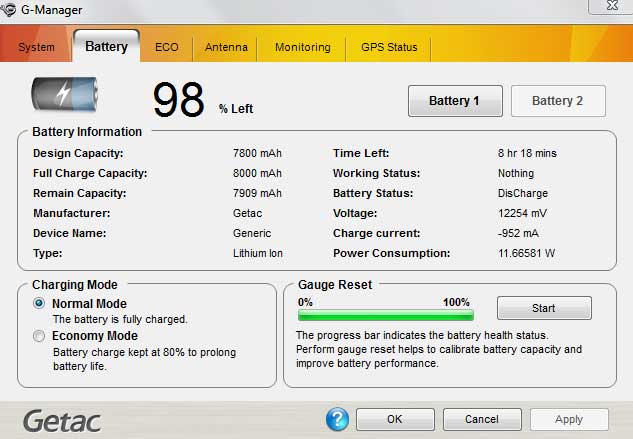
As always, real world mileage will vary. Minimum draw in a test lab is not an accurate predictor of actual battery life (we've seen standard voltage i5/i7 processors draw less than ultra-low-voltage versions). However, between the very good power management of the mobile Intel Core i5/i7 processors, Windows 7's much improved power management, and the Getac S400's extensive power management settings, if the situation requires it, the S400 can run a good long time on a charge. Do keep in mind, though, that power settings do affect clock speed.
Note that Getac also offers an optional light-weight battery with lower capacity (5,200mAH). Unless weight is an issue, we'd stay with the higher capacity battery.
Display
The Getac S400's 14-inch display is large enough to allow working without squinting, and its 16:9 aspect ratio gives the computer a crisp, modern look. The display's 1366 x 768 pixel resolution is just high enough for most work. It is also the same resolution used for 720p HD video, so the display is well suited for multimedia. In terms of screen real estate, compared to the standard 1024 x 768 pixel resolution still used by most rugged notebooks, it's like getting getting an additional third added on the side.
Display size, though, isn't everything. Most rugged notebooks, including the S400, will be used outdoors and sometimes in bright, direct sunlight. Standard transmissive LCD displays, however, wash out in daylight, and that's why over the past few years, sunlight-readability has become a major selling point in the rugged notebook sector. The currently most popular way of making a notebook screen readable outdoors combines various optical treatments to control internal reflection with a strong backlight. Getac uses that approach in the QuadraClear technology used in several of its high-end rugged computers.
From what we can tell, the much lower priced S400 does not use QuadraClear, and the display that comes with the base model, while described as "sunlight readable," has a backlight that is only slightly brighter than that of a standard consumer notebook. Our eval machine, however, came with the optional 700-nit multi-touch display and that's an entirely different story.
A standard notebook backlight is in the 170 to 200 nits luminance range (1 nit = 1 candela per square meter) range. Some manufacturers up the brightness in their rugged products, usually into the 300-400 nits range. Industrial monitors used outdoors generally have 400 to 500 nits. High end rugged notebooks offer anywhere from 500 to over 1,000 nits, with Getac currently holding the record with 1,400 nits in its B300 ultra-rugged. What this means is that the 700 nits backlight of the S400's optional display is much brighter than any consumer notebook.
Since a powerful backlight is hard on the battery, how do you best use the S400's strong backlight? Getac came up with a handy solution with a special button above the keyboard. Push it and the screen lights up with high intensity unseen in any regular display. Having that hardware button is also the key to keeping power draw in check: when you need the extra-strong backlight, switch it on. When you don't need it anymore, turn it off. That's much easier with a button than via menus or function keys (both of which are also available in the S400).
How does it all work in real life? Very well. The pictures below show different scenario comparisons between the S400 and a standard Gateway consumer notebook we use in the lab.
The first picture below shows the two machines outdoors on a bright morning. The Gateway is set to its maximum brightness, and it's actually a good display that is far more readable outdoors than most consumer notebook LCDs. However, you can already see one of the S400 display's big advantages: no reflections. That's because the S400 screen has a semi-matte surface and probably a degree of anti-glare treatment. As a result, there are no reflections whereas the Gateway has sort of a muted mirror-like look.
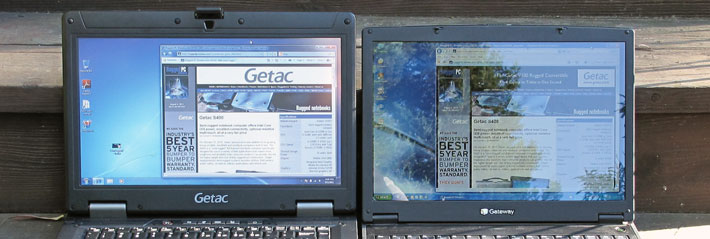
Below are the two machines in broad daylight in partial shade, and viewed from an angle. The glossy Gateway display is now even more mirror-like and largely unusable. The S400 display still shows no sharp reflections, but it turns a little milky. That's usually a combination of the diffusing effect from anti-glare treatment and the changing viewability of the LCD when viewed from an angle.
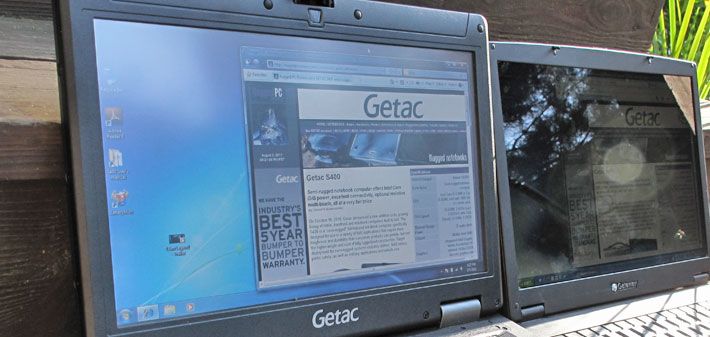
The next picture shows the two machines in open space and broad daylight. Again the high-gloss surface of the Gateway screen renders it unreadable due to reflections whereas the S400's matte display becomes more muted, but has no reflection issues.
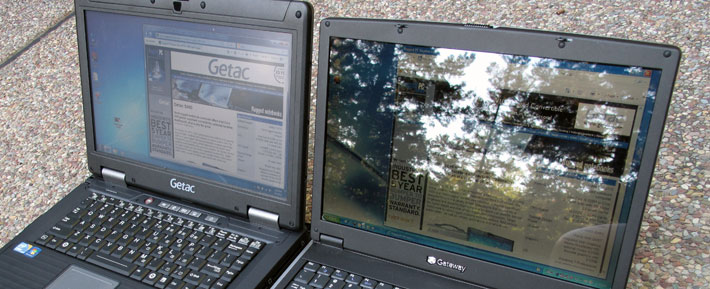
A couple additional comments about the S400 display. You can adjust the backlight from quite dim to full bright in 16 steps via keyboard brightness buttons, and via 64 steps in the Windows control panel. The ability to toggle between standard brightness and full brightness via a hardware button comes in very handy. And there's also a button that let's you turn on and off the backlight and every other source of light on the computer. This may come in handy when the computer is used in vehicles or for certain security reasons.
Viewing angles are important. The horizontal viewing angle of the S400 screen is very good, without any color shifts even when viewed at extreme angles. The vertical viewing angle is also wide, but there are considerable color shifts as you change the angle. This used to be a common problem with TFTs, but there are now technologies that provide perfect viewing angles in all directions, and we hope Getac will consider this soon.
Optional: Multi-touch that works with gloves on
The S400's high-bright display option also includes a multi-touch screen. Standard touch screens only recognize one input at a time, which is exactly what's needed for tapping or writing with a stylus. Today's smartphones and media tablets, however, use capacitive multi-touch technology that recognizes multiple inputs to zoom in and out, pan, and rotate things. 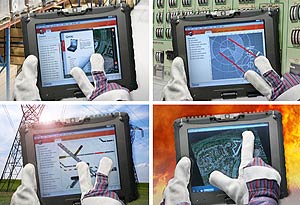 With tens of millions of those phones and tablets in use, many now expect multi-touch functionality. The problem is that projected capacitive touch technology as used on the Apple iPad can neither be used with pens (which are often useful/required in Windows-based systems) nor does it work with gloves on (and gloves are often needed on the job). With tens of millions of those phones and tablets in use, many now expect multi-touch functionality. The problem is that projected capacitive touch technology as used on the Apple iPad can neither be used with pens (which are often useful/required in Windows-based systems) nor does it work with gloves on (and gloves are often needed on the job).
Getac has figured out a way to offer multi-touch that works with gloves on. The way they do it is by using a modified resistive touch technology that subdivides the display into a matrix with a total of 154 zones, and the system can recognize input from two of those zones at a time. That makes the Getac system dual-touch without losing the inherent advantages of resistive touch, i.e. the ability to use a stylus or even operate the display with gloves on. The pictures to the right, demonstrated on a Getac V200, show how it works.
For a more detailed description of the Getac "glove-friendly" multi-touch system, check here. Implementing multi-touch with resistive rather than capacitive technology has its limitations, but it does work. It can be used for both single and dual-touch gestures, and may work best with vertical market custom apps specifically designed for the technology.
Via Windows 7, the S400 has inherent access to a wealth of pen and touch functionality. There's the very useful Snipping Tool, the Windows Journal ink processor, and you can use handwriting recognition via the Windows Input Panel. You can also use just about any other software designed for use with a pen, though keep in mind that resistive touch does not sense the pen floating above the display like an active digitizer does. Also, ink doesn't go on as smoothly in recognition mode.
Wireless and expansion
As is, the Getac S400 comes with a Bluetooth Version 2.1 with EDR (Enhanced Data Rate) class 2 module and Intel Centrino Ultimate-N 6200 802.11a/b/g/n WiFi.
An integrated GPS receiver is optionally available, and for Wide Area Network communication, there is an optional Gobi 2000 module that supports just about any radio and provider worldwide.
As far as expansion goes, there is one PC Card Type II slot and one ExpressCard 34/54 slot. There is also the multi-card reader that was able to read my 32GB SD cards and thus apparently is of the SDHC variety.
While the S400's optical drive is removable, the space where it sits cannot be used for other options as is the case in some of Getac's other models.
Security
Like most mobile hardware these days, the S400 offers various levels of hardware and software security to prevent unauthorized access as well as theft.
Our system included Infineon Technologies' Infineon Security Platform Solution, a very comprehensive security setup that works in conjunction with the S400's Trusted Platform Module (TPM) 1.2 hardware to create and manage computer-generated digital certificates. Combined with software, these certificates can be used to:
- Send and receive secure email,
- Set up the browser for client identification,
- Sign Word macros,
- Encrypt individual files or entire folders, and
- Create secure network connections.
To use TPM, you have to enable TPM support in the BIOS and then configure the system.
Our test system also came with fingerprint registration software that works with the S400's fingerprint scanner.
All of this can get pretty involved. Some users may never implement TPM, fingerprint scanning or even passwords, whereas others may be set up in accordance with their company's IT security procedures, or they may configure an individual system for maximum security.
Over all this, don't forget physical security and get a Kensington locking cable to use with the Kensington slot on the backside of the unit. It is inexpensive insurance against theft.
Additionally, Core i5-equipped S400s can be configured with Intel vPro, a set of technologies to remotely access and control computers securely (see RuggedPCReview.com explanation of Intel vPro).
Getac G-Panel
The new S400 comes with an updated version of the Getac G-Panel that combines a number of special utilities and helper apps that make using the unit quicker and simpler than going to the standard Windows control panels, which can be a cumbersome process.
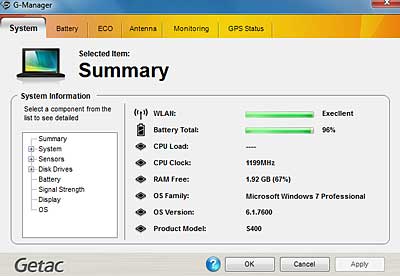
- System provides a one-look summary of all major data, including battery status, CPU load and clock speed, wireless LAN signal strength, free RAM and so on. You can also drill down for more detailed and technical data.
- Battery shows % left in a large numeral, plus just about any other battery statistic you may want. It also shows the current power consumption. With the backlight at its 700 nits maximum, the reading was about 26 watts, with the backlight at minimum and ECO mode engaged, that dropped to 11.5 watts or so.
- ECO displays and controls power savings settings. You can customize the settings and even have certain features such as Bluetooth, WiFi or the touch screen turned off.
- Antenna lets S400 users manage antenna settings for the optional GPS module.
- Monitoring lets you graphically view about a dozen parameters such as CPU clock, load, voltage, temperature; free RAM, LAN stats, etc. They pop up in their own windows, and the only additional wish I'd have is being able to set the graph upper and lower limits.
- GPS Status shows satellites and summary GPS data.
Ruggedness
The Getac S400 is a semi-rugged computer that Getac says was designed "to meet or exceed MIL-STD-810G temperature, shock, vibration specifications including a 2.5 foot drop on six faces." Specs further state that the machine is MIL-STD 810G certified for altitude and humidity as well.
As for more specific environmental specs, the S400 has an operating temperature range of 32 to 113 degrees Fahrenheit, making it suitable for use in most common operating environments, albeit not in freezers, deserts and other extreme temperature deployments. Getac does offer a 5 degree Fahrenheit low temperature option.
As far as sealing goes, the S400 carries an IP5x rating, where the "5" means that the unit is protected against dust (but with limited amounts permitted) and the "x" means that there is no IP rating on protection against water. That's because Getac designed the S400 to handle common occurrences such as spills onto the keyboard and keypad, and most ports have protective covers, but there are also fan and other openings that preclude conventional water ingress resistance testing.
Getac's statement that the unit meets or exceeds MIL-STD-810G temperature, shock, and vibration specifications including a 2.5 foot drop on six faces is somewhat vague, but Getac undoubtedly can produce more detailed test documents. What is clear, though, is that the S400 feels very sturdy and very trust-inspiring. While its looks probably suggest it is even tougher than it is, this machine seems plenty capable of handling the likely abuse encountered in its intended deployment in, as Getac outlines, "utilities, field service, public safety, as well as military applications including vehicle and office use".
Bottom line
The Getac S400 should undoubtedly be seen as one the primary and most competent contenders in the semi- rugged notebook market. It is an attractive, modern and very well executed design that provides Intel Core i3 and i5 power and excellent connectivity to numerous applications where a standard consumer notebook just won't do. Yet, despite its tough and rugged appearance, the S400 is a fairly compact machine that weighs only about 7 pounds.

Equipped with a 2.4 GHz Core i5-520M processor and an optional Intel solid state drive, our S400 test machine provided excellent performance. The S400 does have a small fan, but is fairly quiet and doesn't warm up much. The machine can accommodate up to 8GB of fast DDR3 memory, larger solid state and rotating disks, and it comes with Bluetooth, WiFi and optional Gobi 2000 WWAN for wireless technology and carrier independence. GPS is optionally available as well.
Despite the excellent performance, the S400 offers very good battery life thanks to a large 87 watt-hour battery, Getac's ECO mode settings, and a combination of Windows 7 and Intel core processor power savings technologies. There's an optical drive, but no multi-purpose media bay. "Semi-rugged" design essentially means the ability to survive a reasonable degree of shocks, vibration, spills, etc., without incurring the extra cost and weight of full ruggedness.
The 14-inch wide format display pleases with reasonably high resolution (1366 x 768 pixel) and a semi-matte surface that greatly reduces reflections. Our review unit had the optional 700 nits sunlight readable LED multi-touch display that we highly recommend.
Overall, the Getac S400 is an excellent value that offers very good performance, long battery life, great connectivity, and enough ruggedness for many tasks in an elegant package that fits right into Getac's lineup of tough and rugged machines. Starting price is just US$1,799, but some of the desirable options can add up quickly.
-- Conrad H. Blickenstorfer, August 2011
|
Getac S400 semi-rugged notebook Specifications
|
| Type |
Semi-rugged notebook
|
| Introduced |
October 2010, as a new model
|
| Processor |
Intel Core i5-520M or Core i3-350M, both with 3MB Intel L3 smart cache
|
| CPU speed |
i5-520M: 2.4GHz (up to 2.933GHz with Turbo Boost); i3-350M: 2.26Ghz
|
| Thermal Design Power |
35 watts (both)
|
| Chipset |
Mobile Intel QM57
|
| Graphics |
Integrated Intel Graphics Media Accelerator HD; optional nVidia G310M discrete graphics with 512MB
|
| Display Chipset |
Integrated into processor |
| OS |
Windows 7 Professional
|
| Memory |
2GB DDR3 800/1066MHz, expandable to 8GB |
| Display |
14.0-inch/1366x768 pixel TFT with semi-matte surface |
| Digitizer |
Optional 700 NITs Sunlight Readable LED Touchscreen Display with multi-touch technology |
| Keyboard |
Full-scale mechanical membrane keyboard; optionally available: water-resistant backlit mechanical keyboard
|
| Storage |
320GB SATA hard disk; optional 80GB SSD
|
| Expansion slots |
1 PC Card Type II, 1 ExpressCard 34/54mm, Smart Card, 4-in-1 card reader (SD / MMC / MS / MS Pro)
|
| Housing |
Getac "KryptoShell" material |
| Size |
13.7 x 10.15 x 1.93 inches |
| Weight |
7.0 lbs. as tested, with battery, handle and optical drive
|
| Operating temperature |
32 to 113 degrees Fahrenheit, optional 5F low temperature operation |
| Ingress protection |
IP5x
|
| Drop |
2.5 foot drop on six faces
|
| Humidity |
5% to 95% RH, non-condensing
|
| Other environmental |
MIL-STD 810G certified for vibration, temperature, shock, altitude
|
| Power |
Li-Ion (11.1V, 7,800mAh, 87 watt-hours); optional light-weight Li-Ion smart battery (5200mAh) |
| Interface |
3 USB 2.0, 1 USB/eSATA combo, 1 RS232, RJ45 gigabit LAN, IEEE 1394,VGA, audio in/out, docking; optional: RJ11 modem, RF antenna pass-through for GPS/WWAN
|
| Wireless options |
802.11a/b/g/n WiFi (Intel Centrino Advanced-N 6200), Bluetooth V2.0 + EDR Class 2, optional: GOBI 2000 and GPS with internal antenna
|
| Price |
Starting at US$1,799 |
| Contact |
GETAC us.getac.com |
| Warranty |
3 years (all major system components)
|
Contact
|
ruggedsales@getac.com
www.getac.com
949.681.2900
Getac, Inc.
43 Tesla
Irvine, CA 92618
|
(copyright 2011 RuggedPCReview.com)
|
|








